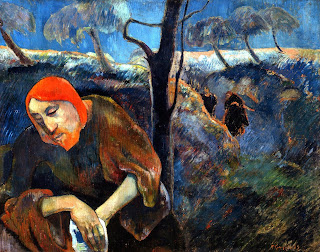 |
| Vahine no te vi
(Woman with a Mango) Paul Gauguin 1892© The Baltimore Museum of Art / Photo: Mitro Hood |
Paul Gauguin (1848 – 1903) painted people throughout his career – from his own family to the Polynesian beauties he found in the South Pacific. This sweeping exhibition brings together more than fifty works from museums and private collections throughout the world, showing how the French artist revolutionised the portrait with his intense use of colour, unconventional symbolism, and lack of flattery or marks of social standing.
 |
| Mette in Evening
Dress Paul Gauguin 1884 © National Museum of Art, Architecture and Design, Oslo |
 |
| Christ in the
Garden of Olives Paul Gauguin 1889 ©Norton Museum of Art |
 |
| Bonjour, Monsieur
Gauguin Paul Gauguin 1889 ©Hammer Museum, Los Angeles |
 |
| L'arlésienne, Mme
Ginoux Paul Gauguin 1888 ©Fine Arts Museums of San Francisco, California |
 |
| Arii Matamoe (The
Royal End) Paul Gauguin 1892 ©Digital image courtesy of the Getty's Open Content Program |
He did, however, enter into relationships with young teenage girls, marrying two of them and fathering children. One 'wife', Tehamana a Tahura, may have been 13 when they met. Christian missionaries had been at work there for decades, compelling the women to wear ‘modest’ dresses based on European models. Gauguin was outraged at this, but featured them in several portraits, including this one of Tahura, which mixes the colonial present with a background of a mythic past.
 |
| The Ancestors of
Tehamana or Tehamana Has Many Parents (Merahi metua no Tehamana) Paul Gauguin 1893 ©The Art Institute of Chicago |
In 1893 he went back to France with a trunkful of exotic clothes and full of his experiences. He painted his studio bright yellow to evoke the atmosphere of the South Seas, and on a return visit to Brittany portrayed a peasant girl at prayer, wearing a brilliant yellow ‘missionary’ dress. But his paintings were not a success, and in 1895 he returned to Tahiti. By this time he was in poor health and had financial worries. In 1901 he moved to Hiva Oa in the Marquesan Islands, where life was cheaper. Here he painted what the exhibition terms ‘Surrogate Portraits’, evoking the memory of friends such as Van Gogh with a still life of sunflowers, and de Haan as a grotesque devil-like figure beside a serene Polynesian couple.
 |
| Contes barbares Paul Gauguin 1902 ©Museum Folkwang Essen / ARTOTHEK |
 |
| Self-Portrait Paul Gauguin 1903©Kunstmuseum Basel |
Gauguin Portraits is at the National Gallery, London until 26 January 2020. Admission charge.
https://www.nationalgallery.org.uk/exhibitions/the-credit-suisse-exhibition-gauguin-portraits
No comments:
Post a Comment